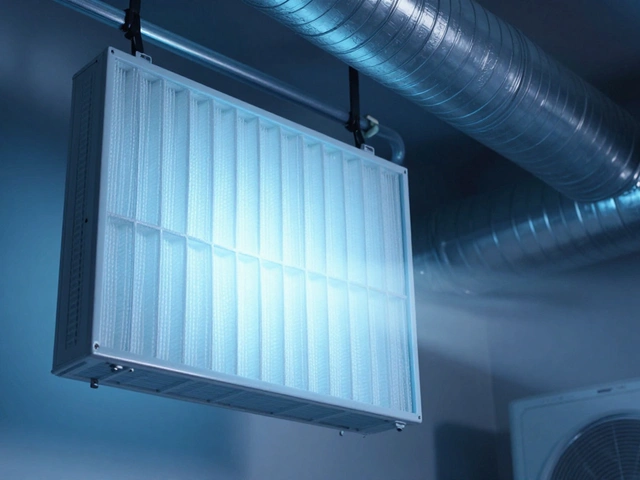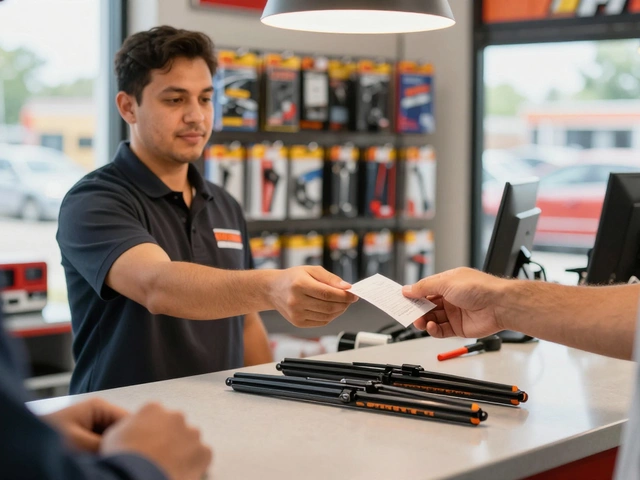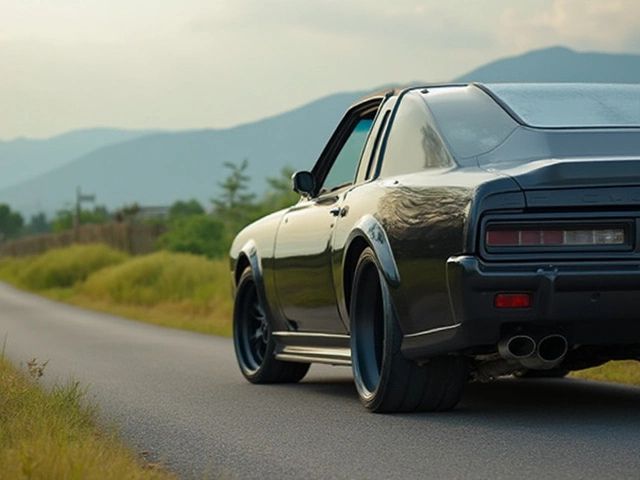Ever wonder why some cars just glide over speed bumps while yours feels like it's skipping across gravel? It usually comes down to suspension health—and it's not just about swapping out old shocks.
Your suspension is a team effort. Springs, shocks, struts, bushings, and even tires play a role in soaking up rough roads. If even one of these is worn out, the whole ride suffers. So, if you’re looking for that buttery-smooth ride, you’ve got to think bigger than just one part.
Don’t ignore little noises or rattles either. That clunk you hear after hitting a pothole could mean something’s loose or busted, and ignoring it only makes things worse—and more expensive. Quick tip: grab a flashlight and take a peek at your suspension parts every few months. Look for cracks in bushings, leaks on shocks, and weird tire wear patterns. They’re your early warning signs.
- What Actually Makes a Suspension Smooth?
- Tire Choices That Change Everything
- Suspension Parts to Inspect or Replace
- Shocks vs. Struts: Which Matters More?
- Leveling Up with Upgrades
- Keep It Smooth: Maintenance Hacks
What Actually Makes a Suspension Smooth?
It’s easy to blame the shocks when your ride turns rough, but there’s a bigger story here. Suspension smoothness is like a team sport—it takes a bunch of different parts, all working together, to keep rides cushy in your car.
Here’s what does the heavy lifting:
- Springs (coil or leaf): They hold up the weight of your car and absorb the major bumps.
- Shocks and struts: These aren’t just simple add-ons. They calm down all that bouncing, making sure your wheels stay planted instead of hopping like a rabbit.
- Bushings and joints: These rubbery bits keep everything connected but flexible. When they wear out, expect more rattles and a choppier ride.
- Tires: Believe it or not, tires are your ride’s first line of defense. The type, size, and air pressure all play a part in soaking up bumps.
Here’s a quick snapshot showing how each part affects your smooth ride:
| Part | Main Job | Impact on Comfort |
|---|---|---|
| Springs | Absorb heavy loads & big hits | Major |
| Shocks/Struts | Dampen bumps and motion | Major |
| Bushings | Reduce vibration/noise | Medium |
| Tires | Soften minor road bumps | Medium/High |
Most folks don’t realize just how much their suspension parts are doing, even on good roads. If you’re starting to notice more shaking or knocking sounds, it usually means some part of that system isn’t pulling its weight anymore. Regular checks save you a ton of headaches.
Tire Choices That Change Everything
If your car feels stiff or jittery, don’t just blame the springs or shocks—start with the tires. They’re the first thing between your car and the road, and honestly, most folks overlook how much tire choice affects the smooth ride and car comfort.
Here’s the thing—hard, low-profile tires (the ones with smaller sidewalls and bigger wheels) might look cool, but they make every crack and bump feel twice as harsh. Want more cushion? Go for tires with taller sidewalls. They act almost like a mini suspension, absorbing the chatter and softening harsh hits. For daily driving, all-season tires usually offer the best mix of comfort and grip.
- Proper tire pressure is often overlooked. Too much pressure? Your ride gets rough and bouncy. Too little? It feels mushy and unstable. Check your tire label (inside your driver’s door) and stick to it.
- Tire brand and model actually matter. Some brands are known for softer compounds and sturdy sidewalls—Michelin Primacy and Continental PureContact, for example, are favorites for those who want that floating feeling.
- Don’t mix and match tires with different tread patterns or levels of wear. It can throw your whole suspension off and make the ride unpredictable.
Check out how the main tire features affect your ride:
| Tire Feature | Impact on Ride Comfort |
|---|---|
| Low-Profile (Short Sidewall) | Harsher, sportier feel |
| Tall Sidewall | Softer, more forgiving ride |
| All-Season Compound | Balanced comfort and grip |
| Performance Compound | Bumpy, but sharper handling |
Before swapping anything else, try adjusting tire pressure or even changing setups within recommended specs. Plenty of drivers see a big difference with just new tires—sometimes it’s like turning your car into a whole new machine.
Suspension Parts to Inspect or Replace
If your ride feels rough, it’s time to get serious about which suspension parts need your attention. Most people think only about shocks, but there’s a whole crew under your car making the difference between butter-smooth and bone-rattling.
Here’s where you need to look:
- Shocks and Struts: These guys do a lot of the heavy lifting. If your car bounces more than once after hitting a bump, odds are your shocks or struts are wearing out. Leaks, dents, or rust on them are dead giveaways you need a replacement.
- Springs: Coil and leaf springs keep your car at the right height and help absorb impacts. If your car looks lower on one side, a spring might be broken or sagging.
- Bushings: These rubber parts cushion where metal meets metal. Cracked or squished bushings mean more vibration and squeaks. They’re cheap to replace but make a huge difference for car comfort.
- Control Arms and Ball Joints: These connect your wheels to the frame and keep steering tight. Worn ball joints make your steering loose and add clunks on every bump.
- Sway Bar Links: These parts keep your car from rolling too much in turns. Bad sway bar links mean more body roll and handling that feels sloppy.
Don’t forget the tires—they're technically part of your suspension system and can make or break a smooth ride. If they’re worn unevenly, hard as a rock, or old, you’re not going to get much comfort no matter what you do with the other parts.
| Part | How to Check | When to Replace |
|---|---|---|
| Shocks/Struts | Bounce test, look for oil leaks | Every 50k-100k miles, or if leaking |
| Springs | Inspect ride height, listen for squeaks | If sagging, cracked, or broken |
| Bushings | Look for cracks or missing rubber | If cracked or worn |
| Ball Joints/Control Arms | Check for looseness, clunking sounds | When loose or noisy |
| Sway Bar Links | Check for looseness, rattling | If noisy or loose |
Regular checks keep you ahead of bigger problems. If you’re not sure about your suspension parts, ask a shop for a quick inspection—it’s often free or cheap and could save you hundreds down the line.

Shocks vs. Struts: Which Matters More?
When it comes to getting a smooth ride, people always want to know whether shocks or struts are more important. Here’s the truth: they both matter a ton, but in different ways. Shocks and struts do kind of the same job—keeping your tires on the road and soaking up bumps—but the design is totally different.
Shocks are like the referees in your suspension system. Their main job is to control the bounce in your springs. No matter how heavy your car or truck, without decent shocks, you’ll feel every pothole twice—once when you hit it, and again when your car bounces back up. They don’t support weight, but they make the ride a lot more controlled.
Struts, on the other hand, are multitaskers. They act as both a shock absorber and a structural part of your suspension and steering. Most cars have either front struts or shocks, depending on design. If you swap out old struts for new ones, you can radically improve how your car feels—even if your shocks are decent. This is especially true for smaller cars and SUVs, where struts are pulling double duty.
"Replacing worn out shocks or struts can improve ride comfort and handling by as much as 50%, especially in vehicles with over 80,000 miles on them." — Gabriel Suspension Tech Report, 2019
Here’s where it gets practical: If you’re chasing that car comfort on a budget, figure out which ones are failing first. Push down a corner of your car and see if it bounces more than once or twice—that’s a sign you’ve got weak shocks or struts. Look for oily leaks, too. If your car feels floaty, sways around corners, or dips when you brake, odds are good you need new struts.
- Shocks: Control spring movement, don’t hold weight, usually cheaper to replace
- Struts: Combine structural support and shock absorption, more expensive, bigger ride improvement
If you like data, take a look at this rough breakdown of effects reported after replacement jobs:
| Replacement | Ride Smoothness | Cost Range (USD) |
|---|---|---|
| Front Shocks Only | 20-30% smoother | $250-$400 |
| Front Struts | 30-50% smoother | $350-$700 |
| All 4 Shocks/Struts | Up to 70% smoother | $700-$1500 |
Bottom line: if your goal is the smoothest possible suspension and you haven’t changed your struts or shocks in years, start there. It’s the quickest win for making every drive feel like you’re cruising on air.
Leveling Up with Upgrades
If you want the smoothest ride possible, sometimes factory parts just don’t cut it. Upgrading your suspension can make a night-and-day difference, especially on cars built for handling or trucks weighed down by gear. But what are your best bets when it comes to upgrades?
First off, swap out old shocks and struts for ones designed for comfort, not just stock replacements. Brands like Bilstein and KYB offer premium shocks that eat up potholes like they’re barely there. If you drive on rough roads all the time, gas-charged shocks are your friend because they handle high temps and stay consistent after miles of abuse.
Consider replacing your springs with progressive-rate springs. Unlike standard springs, these get stiffer as they compress, so you get a plush ride over little bumps but extra support if you hit something bigger or the car is loaded up.
Don’t forget the suspension parts most people skip: bushings. Rubber bushings crack and squish over time, soaking up less of those annoying little vibrations. Upgrade to polyurethane bushings for a longer-lasting, slightly firmer feel. They won’t turn your ride into a race car, but you’ll notice fewer squeaks and rattles.
On top of that, adjustable coilovers give you maximum control. Want more comfort on your commute or extra support with a full load? Dial them up or down, no tools required. If you’re hauling or towing, check out air suspension kits. They help you stay level and avoid that bouncy, out-of-control feeling.
If you’re really chasing comfort, look at the numbers before you buy. Here’s a quick snapshot of what some upgrades can do:
| Upgrade Type | Ride Quality Improvement | Avg. Cost Range |
|---|---|---|
| Premium Shocks (Bilstein, KYB) | 20-30% smoother | $250-$500/set |
| Progressive Springs | Better over potholes | $200-$350/set |
| Polyurethane Bushings | No more squeaks, tighter feel | $100-$250 full kit |
| Adjustable Coilovers | Custom ride height/feel | $700-$1500/set |
| Air Suspension | Best for heavy loads | $1200-$3000+ |
The thing is, you don’t have to do it all at once. Pick the weak spot that bugs you most—maybe your shocks are tired, or your bushings creak every time you pull onto the driveway—and start there. Upgrading even one key component can make your ride feel like a totally different machine.
Keep It Smooth: Maintenance Hacks
If you want a smooth ride, it’s not about dropping cash on fancy upgrades—you just need a solid maintenance routine. Most suspension issues come from basic wear and tear that you can spot (and fix) before it gets bad.
Start simple: check your tire pressure monthly. Low or uneven pressure will mess up your ride feel, no matter how good your suspension is. Look for funky tread wear too. This can actually point to issues with your suspension parts, like worn bushings or bad shocks.
Every 10,000 miles (or about every other oil change), do a visual inspection under your car. Here’s a quick checklist:
- Look for leaks around your shocks and struts—if they’re oily, they’re probably done for.
- Check bushing rubber for cracks—that’s a sign they need swapping.
- Give your steering and ball joints a wiggle; too much play means trouble.
- Peek at your springs for rust or breaks. If they’re sagging, that’s a red flag.
Don’t forget wheel alignment. Bad alignment makes your car pull to one side and chews up tires, which means your ride comfort tanks. Realignment every 1-2 years, or after thumping a big pothole, goes a long way.
Sometimes you can catch big problems early just by listening to your car. Turn the music off and listen for new clunks, squeaks, or rattles. That’s your car talking to you.
If you want to take it to the next level, swap out bushings for polyurethane ones. They last longer and keep things stable, especially on rough roads.
An old survey by Consumer Reports found that drivers who stuck to regular suspension maintenance spent 40% less on major suspension repairs over a five-year period compared to those who skipped maintenance. That’s hard cash saved for, well, anything more fun than fixing car parts.
Marty Padgett, editor at The Car Connection, says: "You don’t have to be a mechanic. Start with the easy stuff—check your tire pressure, listen for weird noises, and keep up regular checks. That’s half the battle for a smooth, quiet ride."
| Maintenance Task | How Often |
|---|---|
| Tire Pressure Check | Monthly |
| Visual Suspension Inspection | Every 10,000 miles |
| Wheel Alignment | Every 1-2 years |
| Bushing Check | Every 10,000 miles |
Look after your suspension parts, and your car will reward you with a ride that won’t rattle your teeth every time you hit a bump. It’s not rocket science—it’s just about keeping up with the little stuff, before it turns into a big headache.










Write a comment